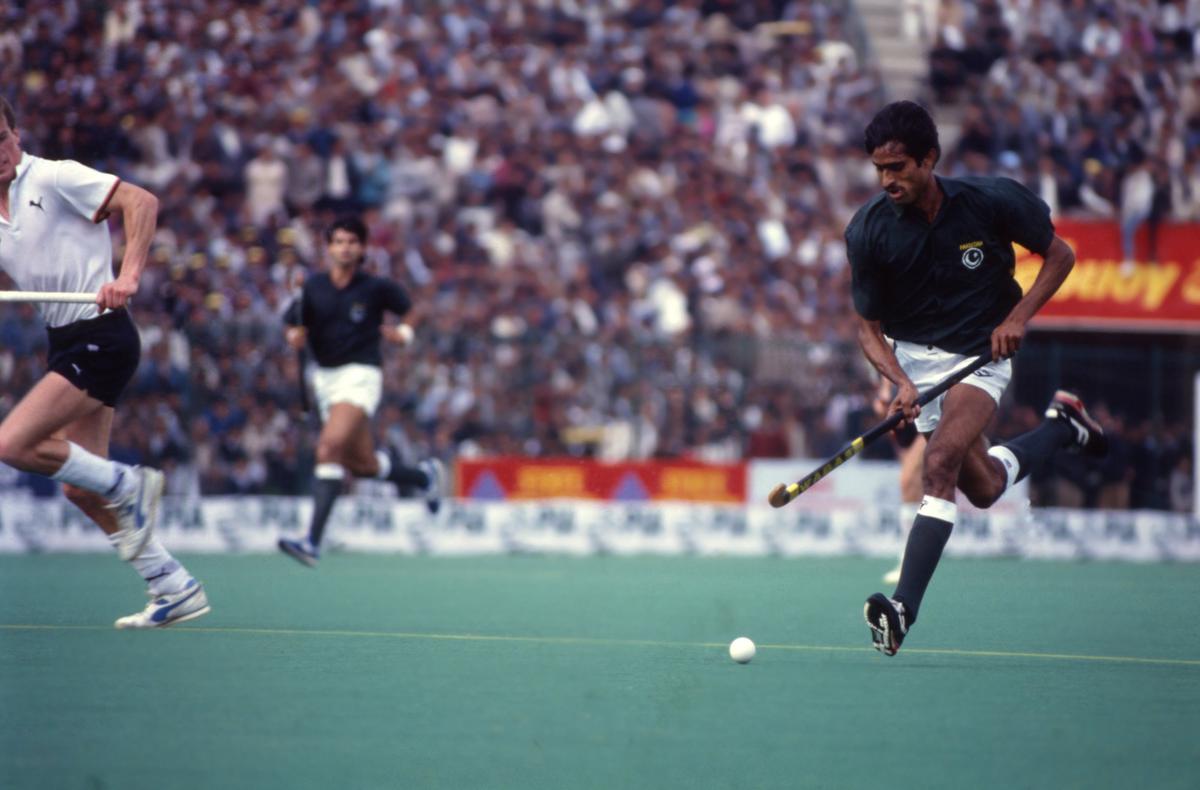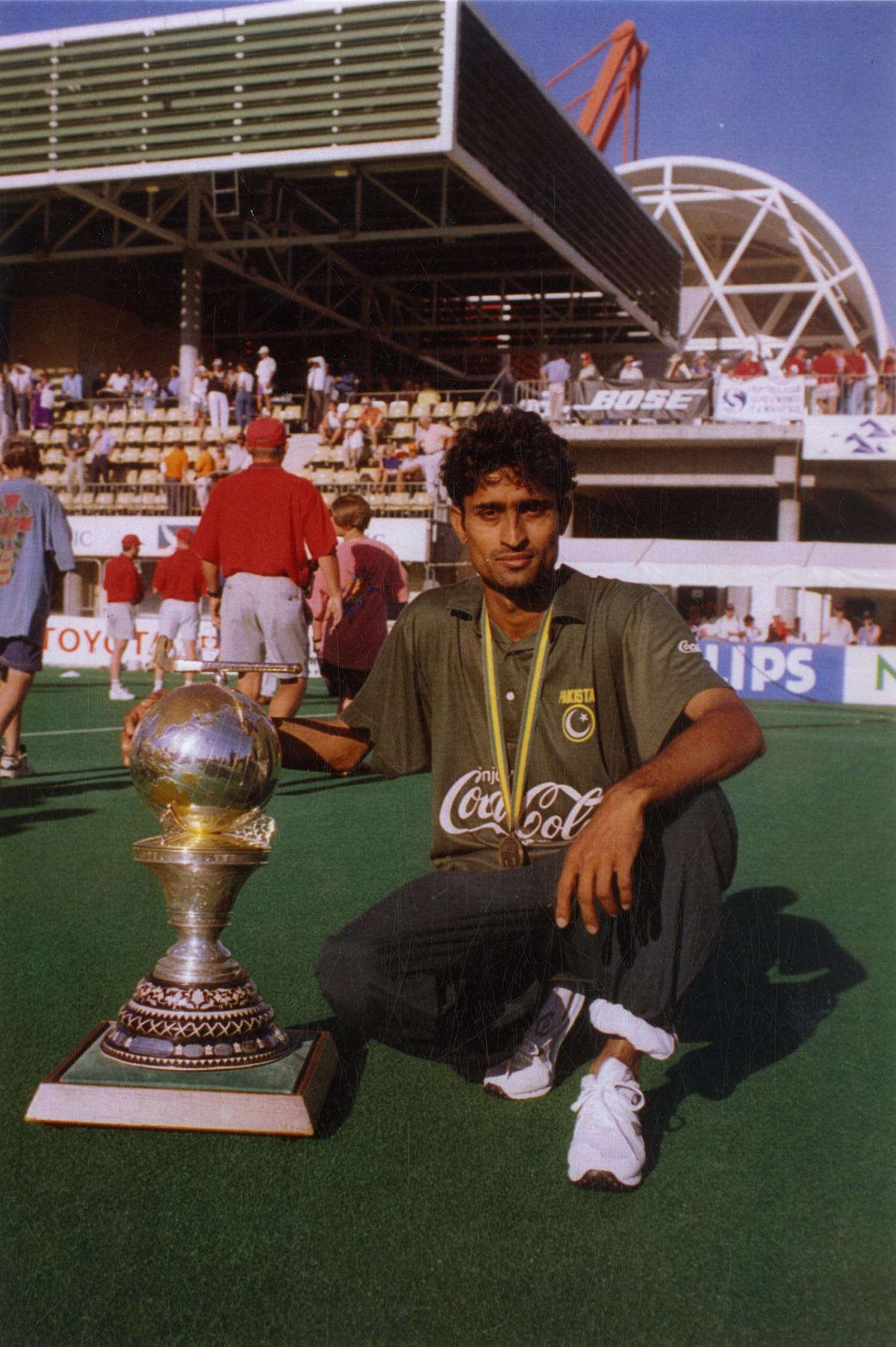Mornings in Lahore are unhurried. As the city slowly stirs to life, a steaming cup of doodh patti tea, flaky parathas, and a serving of halwa are breakfast staples.
But Shahbaz Ahmed Sr. is an early riser, known for his punctuality.
It was no surprise that he arrived at the roof-top cafe on MM Alam Road — nestled in the heart of the city — 10 minutes ahead of schedule. As he put it, it’s this ‘discipline’ that keeps him going.
A former Pakistan hockey captain and a legend of the game, Shahbaz was renowned for his razor-sharp passes to centre-forwards, earning him the title of ‘Maradona of hockey’. While he appreciates the moniker, he is deeply saddened by the current state of Pakistan hockey.
Over a breakfast of paratha and garam ande (eggs) — two quintessential Lahori delicacies — a nostalgic Shahbaz reminisced about leading Pakistan to victory at the 1994 World Cup in Sydney, one of the nation’s greatest triumphs in its ‘national sport’.
Midway through the conversation, nostalgia took over. Shahbaz paused, picked up his phone, and dialled an old friend — former India captain M.M. Somaya — to relive past memories. He acknowledged that the Odisha government’s investment and support have significantly boosted Indian hockey in recent years.
In an exclusive chat with Sportstar, the former captain and erstwhile administrator reflected on Pakistan hockey’s golden years and how the country has struggled to sustain its rich legacy.
What are your thoughts on the current state of Pakistan hockey?
Hockey has struggled to attract young players, and our performances in major international events reflect that decline. We are out of the World Cup and the Olympics, and there is no guarantee of jobs for those who take up the sport. As a result, the younger generation has moved on.
We have talent, but there is a lack of passion. I miss that junoon — the hunger among young players to step up, play the game, and carry forward the legacy.
Another major issue is that after playing at the local or junior level for a few years, many players leave to compete in sub-standard overseas leagues in Hong Kong, Malaysia, and Thailand for the sake of earning $1,000 or $2,000. They lack the quality to secure spots in top leagues in Germany or the Netherlands, so they settle for these smaller competitions. Unfortunately, this stagnates their growth, and they fail to progress further.

Livewire: Shahbaz Ahmed of Pakistan, a dynamic force in attack, showcased his touch-tap-dribble skills to dismantle defences during the 1990 Hockey World Cup in Lahore.
| Photo Credit:
The Hindu Archives
Livewire: Shahbaz Ahmed of Pakistan, a dynamic force in attack, showcased his touch-tap-dribble skills to dismantle defences during the 1990 Hockey World Cup in Lahore.
| Photo Credit:
The Hindu Archives
But why are young players moving to these smaller leagues? At a time when India is reviving its love for hockey, what is holding Pakistan back?
The main issue is a lack of proper patronage. Hockey is our national sport, yet it is not part of the national budget. Players are aware that there are no secure jobs, and since we play only two or three international tournaments a year, the financial incentives are minimal. This uncertainty pushes them towards leagues in Hong Kong or Malaysia, where they can at least earn a living.
Unless we streamline our system and establish a Centre of Excellence, revival seems difficult. Despite once dominating the sport, we have fallen behind — disconnected from major leagues and global events. Our physical fitness levels are also not on par with international standards. Collectively, these factors have left us trailing far behind.

One to keep: Shahbaz Ahmed shows his Sportstar magazine poster to teammates during a break in practice before the final Test against India in Chennai on March 26, 1998.
| Photo Credit:
The Hindu Archives
One to keep: Shahbaz Ahmed shows his Sportstar magazine poster to teammates during a break in practice before the final Test against India in Chennai on March 26, 1998.
| Photo Credit:
The Hindu Archives
India has revived hockey in recent years. What do you think has driven this turnaround?
The state of Odisha has made massive investments in Indian hockey, which is remarkable. In Pakistan, the interest simply isn’t there. It’s not just about funding — it’s about prioritising the sport.
India will also benefit from the relaunch of the Hockey India League earlier this year. Their women’s team has broken into the world’s top four, while the men’s team competes in the Pro League and has won medals at the Olympics and World Cup. India has embraced hockey professionally, and once a structured system is in place, a strong talent pipeline naturally develops.
With financial backing, India has hired top coaches at various levels, and the players have reaped the rewards. Crucially, every Indian player competes in around 40-50 matches annually, boosting confidence and teamwork.
Meanwhile, our cycle has stalled. Even if we secure the same level of funding as India, it will take at least five years to rebuild. The first challenge is bringing young players back, refining their skills, and preparing them for top-tier competition against teams like the Netherlands, Belgium, and Germany.
If you look at our players’ statistics, their ball possession and touch rates barely exceed 10-15 minutes across three or four tournaments. That’s simply not enough for players aiming to compete at the highest level.
Hockey India is led by former captain Dilip Tirkey. You were once part of the Pakistan Hockey Federation. Should Pakistan bring in an ex-player to lead its hockey administration?
The real issue is that we never built a proper system. We couldn’t even plan a fixed calendar — whether the team would travel to Europe or elsewhere remained uncertain. Without a steady flow of funds and a structured process, it’s impossible to move forward.

Top of the world: Pakistan captain Shahbaz Ahmed poses with the World Cup after his team’s tie-breaker win over the Netherlands in the 1994 Hockey World Cup final in Sydney on December 4.
| Photo Credit:
The Hindu Archives
Top of the world: Pakistan captain Shahbaz Ahmed poses with the World Cup after his team’s tie-breaker win over the Netherlands in the 1994 Hockey World Cup final in Sydney on December 4.
| Photo Credit:
The Hindu Archives
Revival is difficult because hockey has become an expensive sport. Travel costs have soared, and equipment — shoes, sticks, and other gear — is now costly. Unlike other nations, we lack a system where talent-hunting programmes provide proper accommodation or hockey hostels for young players.
When I visited Bhubaneswar a few years ago, I was amazed by the state-of-the-art facilities at the stadium. It was a world-class venue. Whoever takes charge in Pakistan must prioritise developing such venues with complete infrastructure.
Hosting major tournaments is key. When international events take place at home, young players learn far more by watching top-level competition than by reading about it.
Pakistan failed to qualify for the last three Olympics and two of the last three World Cups. Does that hurt?
It’s hard to put my feelings into words. Whenever our teams play — even in friendlies — I struggle to watch. It breaks my heart.
When I saw the 2021 Olympic final, I realised the standard wasn’t particularly high, yet Pakistan wasn’t even there. That hurt even more. When we played, the game’s quality was far superior — it’s simply not comparable to today.

Grand welcome: Star forward Shahbaz Ahmed (wearing spectacles) and captain Tahir Zaman (right) arrive at the Indira Gandhi International Airport on March 17, 1998, ahead of the Test series against India. Pakistan won the eight-Test series 4-3, with one game ending in a draw.
| Photo Credit:
THE HINDU ARCHIVES
Grand welcome: Star forward Shahbaz Ahmed (wearing spectacles) and captain Tahir Zaman (right) arrive at the Indira Gandhi International Airport on March 17, 1998, ahead of the Test series against India. Pakistan won the eight-Test series 4-3, with one game ending in a draw.
| Photo Credit:
THE HINDU ARCHIVES
But I don’t blame the players. This is a failure of investment and legacy-building, not individual effort.
That said, things can improve. Government backing and visionary leadership are crucial. We need a technocrat who understands an athlete’s struggles and can manage the calendar to bring long-term benefits. If these changes happen, hockey has a future. I’d be happy to help the government or any organisation working to revive the sport. I can share my experience with young players, but the system must first improve.
Is skillset making the difference between Indian and Pakistani players?
Skillset is not the main difference between Indian and Pakistani players; rather, it is the system that develops them for high-performance hockey. The key factor is how well players execute game plans and fulfil their roles within the team’s structure—essentially, their game intelligence.
Indian players tend to utilise their skills more effectively, adapting to the playing conditions and match situations with greater precision.
You praised the Hockey India League. Should the PHF consider launching a similar tournament?
Absolutely. A premier hockey league would provide young players with financial support and exposure.
Beyond that, our national team must tour abroad for 3-4 months every year, ensuring each player competes in at least 30 high-quality matches.
That’s the only way to groom talent and gain international experience.
You had a long and successful career. What’s your most cherished memory?
I played for Pakistan for 18 years, one of the longest-serving members of the team. Some moments will always stay with me. In 1987, when I played the Indira Gandhi Gold Cup in India, massive crowds turned up to support us. Fans carried banners calling me ‘Superman’ and chanted my name. That was unforgettable.
Another moment was the 1994 World Cup final in Sydney. Fans from New Zealand and Australia approached me, saying, “You’re the only one who truly knows how to play hockey.” Such encouragement and respect kept us going.






